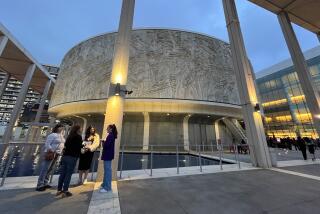Stage Is Being Set for Yet Another Role for Theater
The sign, though weathered and peeling, is still readable: Dorill B. Wright Cultural Center.
But the hopes and ambitions for the 20-year-old Port Hueneme performing arts center have all but faded away, evidenced by the “For Sale” sign still out front. Now its new owners are proposing to convert the 564-seat seaside theater into an adult day-care center.
“I’m not too thrilled,” Wright, 82, said when he learned about the proposal this week.
As a former mayor, Wright pushed for the arts center, believing it would enhance residents’ quality of life. At the theater’s gala opening Sept. 8, 1984, he gushed, “It’s even better than I dreamed,” according to one newspaper account, while the Ventura County Symphony Orchestra kicked things off with an appropriate “Victory at Sea” by Richard Rodgers.
Reached this week at his home near the center, Wright talked about that long-ago night.
Admission was free and everyone was invited for the ribbon-cutting and concert. The stage was just big enough, he recalled, to fit all the orchestra members. After intermission, conductor Frank Salazar “reached down and patted the floor and said, ‘Don’t listen to us, listen to the building.’ ”
The acoustics were one of the best things about the place, said Denis Murrin, who managed the center for five years, then became the city’s facility maintenance superintendent when the theater closed in 1993.
“That room could handle a one-person recital onstage without any amplification, then you could turn around and put a rock band onstage with way too much sound and it was still distortion-free,” he said.
When Murrin took over in late 1988, the theater was already having problems. Its previous director had left in May of that year after assembling three resident performance groups -- a dance troupe, a chamber orchestra and an Actors Equity group.
But that was costly and by 1989 sponsorship of those groups had ended. Acts were expected to split the costs of mounting their productions along with the profits.
Murrin shortened the runs of plays so more seats would be filled, and brought in new types of acts, ranging from the Glenn Miller Orchestra to Soupy Sales to the Shanghai Acrobats.
The Glenn Miller Orchestra was Murrin’s favorite event. The theater’s seats could be retracted, so dancing often would be offered along with the music.
“It was the first event that ever sold out the house,” Murrin said. “It was kind of neat, because all the old people would sit there with tears in their eyes.”
The theater was a popular destination for performers, who sometimes would add it to a Los Angeles gig so they could stay in the area, he said.
“I could sit in my office and be looking at palm trees and the beach,” Murrin said. “I’d be talking to New York, where it was cold or snowing, and the booker would say, ‘Maybe we’ll come. Maybe I should come out and watch that show too.’ ”
But the audience needed to support the facility didn’t show up in great enough numbers in those early years. The theater was miles from any freeway.
“The location worked very badly in terms of marketing,” Murrin said. “From the 101, it’s kind of out of the way, and easy to get lost.”
Things picked up in the early ‘90s after Murrin broadened the variety of shows and concerts and booked more community events.
The center attracted nearly 24,000 people in 1992, up from 3,300 in the 1988-89 season.
But the city’s budget problems were mounting, and it could no longer afford the $150,000 annual subsidy for theater operations.
By 1993, when the city was trying to decide whether to cut police services or close the theater, its fate became clear. “People would say, ‘When your house is being robbed, you don’t call the cultural center,’ ” Murrin said.
On May 8 of that year, with little fanfare and short advance notice, the facility staged its last concert, by the Aman Folk Ensemble.
For the next few years the theater remained dark. The city maintained the building while trying to figure out what to do with it. In 1999, it was put up for sale.
Pacific Coast Entertainment paid $1.1 million for the facility, renamed it Beachfront Studio and announced plans for a film festival and Hollywood film productions.
One festival was held, in October 2000. But by September 2002, the building was for sale again.
In February, Camarillo-based Alpan Lighting purchased the facility for $2.6 million. Company President Daniel Sooferian declined to detail his plans for the facility.
But Greg Brown, Port Hueneme’s community development director, said the company had submitted applications to run a day-care center for up to 300 adults out of the facility.
“That’s what’s going to pay the bills,” Brown said.
He said the company had said the center would be open to adults suffering from cerebral palsy, autism, epilepsy or developmental disabilities.
The city has not made any decisions on the tentative proposal, which faces an extensive review process, Brown said.
“They’ve submitted an application, but it keeps changing,” he said.
Meanwhile, the building sits across the street from Port Hueneme’s pier, nestled between a park and a condominium complex, still carrying the name of the man who helped fight for it and who attended many shows there.
“I went practically every time the performance changed,” Wright said.
Wright, who is recovering from heart-bypass surgery, was a Big Band fan, but get him started and he remembers the acrobats and “The Pirates of Penzance” and a cowboy poet show, all of them made even more special by being staged in an intimate theater with great acoustics.
“It offered a thrilling venue while it was working,” he said.
More to Read
The biggest entertainment stories
Get our big stories about Hollywood, film, television, music, arts, culture and more right in your inbox as soon as they publish.
You may occasionally receive promotional content from the Los Angeles Times.










